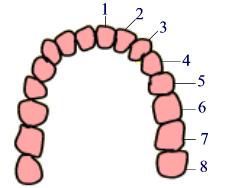Try the Quiz : Biology : Human Organ Systems II
 |
apid |
Just what you need to know! |
| eview |
|
QUESTION :
ANSWER :
EXPLANATION- Which of the following is not true?
A. Heart rate in a healthy human adult is 60-64 beats per minute.
B. Oxygen is transported to various parts of the body through blood.
C. White blood cells help the body fight against infections.
D. Platelets play an important role in clotting of blood. : A
- Heart rate in a healthy human adult is 72-78 beats per minute.
- _______ are formed by the division of trachea. : Bronchi
- Which of the following helps keep the human body cool?
A. Respiration
B. Mastication
C. Perspiration
D. Urination : C
- Which of the following is not a function of the large intestine?
A. Absorption of water
B. Formation of feces
C. Churning of food
D. Absorption of salts : C
- Churning of food occurs in the stomach.
- Which type of teeth are used for tearing the food? : Canines
- There are four types of teeth in adult humans:
1. Incisors (8 in number) - flat chisel-shaped front teeth used for cutting food
2. Canines (4 in number) - pointed corner teeth used for tearing the food.
3. Premolars (8 in number)
4. Molars (12 in number)
Premolars and molars are the back teeth with broad tops that are used for chewing and grinding the food.
- Incisors are used for _______ the food. : cutting
- There are four types of teeth in adult humans:
1. Incisors (8 in number) - flat chisel-shaped front teeth used for cutting food
2. Canines (4 in number) - pointed corner teeth used for tearing the food.
3. Premolars (8 in number)
4. Molars (12 in number)
Premolars and molars are the back teeth with broad tops that are used for chewing and grinding the food.
- Main function of molars and premolars is _______ the food. : grinding
- There are four types of teeth in adult humans:
1. Incisors (8 in number) - flat chisel-shaped front teeth used for cutting food
2. Canines (4 in number) - pointed corner teeth used for tearing the food.
3. Premolars (8 in number)
4. Molars (12 in number)
Premolars and molars are the back teeth with broad tops that are used for chewing and grinding the food.
- _______ filter the blood to excrete harmful substances in the form of urine. : Kidneys
- There are two kidneys, bean-shaped in structure. Kidneys filter the blood and excrete waste products in the form of urine. Urine formed in the kidneys is passed to the urinary bladder via two ureters.
- Bile is secreted by the : liver
- Bile is a green-colored fluid secreted by the liver and stored in the gall bladder. It is necessary for digestion and absorption of salts.
- Voice box is the name given to the : larynx
- Which of the following helps in digestion?
A. Pancreatic juice
B. Saliva
C. Bile
D. All of these : D
- Food descends from the mouth to the stomach through the : esophagus
- Esophagus is a tubular structure which joins the mouth to the stomach. Its length is about 30 cm.
- Larger dust particles in the inhaled air are trapped in the : nose
- Gastric juice is secreted by : stomach
- Gastric juice is secreted by the stomach. It contains acid and enzymes which help in the digestion of food.
- 'C' shaped rings of cartilage are present in the : Trachea
- There are about 16-18 rings of cartilage present in the trachea. They prevent the trachea from collapsing.
- What is the name of the sac-like structure which stores urine? : Urinary Bladder
- Urine formed in the kidneys is passed to the urinary bladder via two ureters and is stored there till it is excreted out.
- True or false: Exchange of air takes place in the lungs. : True
- True or false: CO2 is formed as a waste product during respiration. : True
- Epiglottis guards the opening of larynx into pharynx. : True
- Epiglottis is a leaf-like projection behind the tongue. It prevents the food from entering into air passages.

QUESTION :
ANSWER- What type are teeth 1 and 2 in the following diagram? : Incisor
- What type is tooth 3 in the following diagram? : Canine
- What type are teeth 4 and 5 in the following diagram? : Premolar
- What type are teeth 6, 7 and 8 in the following diagram? : Molar
Try the Quiz : Biology : Human Organ Systems II

